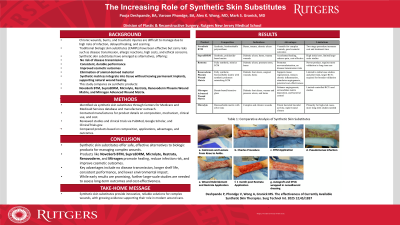Practice Innovations
(PI-009) The Increasing Role of Synthetic Skin Substitutes

Acute and chronic wounds continue to remain a challenge to heal. Infection, scarring, and surgical morbidity are problematic. As the industry has produced a wide array of Cellular, Acellular, and Matrix-like Products (CAMPs) active in wound healing, a new class of synthetic skin substitutes has developed in parallel. The products are off the shelf, cost-effective, and avoid the issues of using biologic tissue implants in patients. In addition, some have antimicrobial activity or are resistant to infection.
Methods:
The CMS database was accessed to identify synthetic skin substitutes. The structure, activity, and background research were sought for the 6 identified products by consulting the databases of Pubmed, Clinical Trials.gov, and Google Scholar. The product companies were contacted for further information regarding the mechanism of action, risks and complications, indications, and clinical experience. The products included a foam-based wound surface closure device designed originally for burns but equally effective in other wounds. Two products were identified using an electrospun technique for creating nanofiber matrices. Both employ dissolvable and resorbable synthetic polymers. Another matrix product is made of polylactide-based molecules that produce lactate as it dissolves. This promotes antimicrobial activity and additional cellular functions necessary for healing. There is also a product constructed of resorbable Borate bio-glass, which releases boron, calcium, and magnesium when dissolved. These chemicals mediate healing activities in the wound. Finally, a bioresorbable matrix containing ionic and metallic silver is focused on treating biofilms and wounds with high bacterial contamination.
Results:
These products have been shown to be clinically effective in promoting wound healing in both acute and chronic wounds. Some have demonstrated decreased healing times. As a group, they have improved granulation tissue formation in various challenging wounds and improved cosmesis in the healed wounds. The products are more resilient and require less post-operative care than many CAMPs. There have been remarkably few complications associated with their use. There is still a paucity of studies to support the wide use of the newly introduced class of materials, but they will inevitably enter the mainstream of wound care.
Discussion:
A new class of synthetic skin substitutes is emerging. These products have varied components and structures and are all resorbable. The first of these products was developed to treat burn injuries but has been utilized to treat a wide variety of wounds. We continue to learn how to employ these synthetics best and look forward to seeing the emerging literature.

.jpg)